 | ÐлекÑÑоннÑй компоненÑ: ADUM1210 | СкаÑаÑÑ:  PDF PDF  ZIP ZIP |
ADuM1210 Dual-Channel Digital Isolator Data Sheet (Rev. 0)
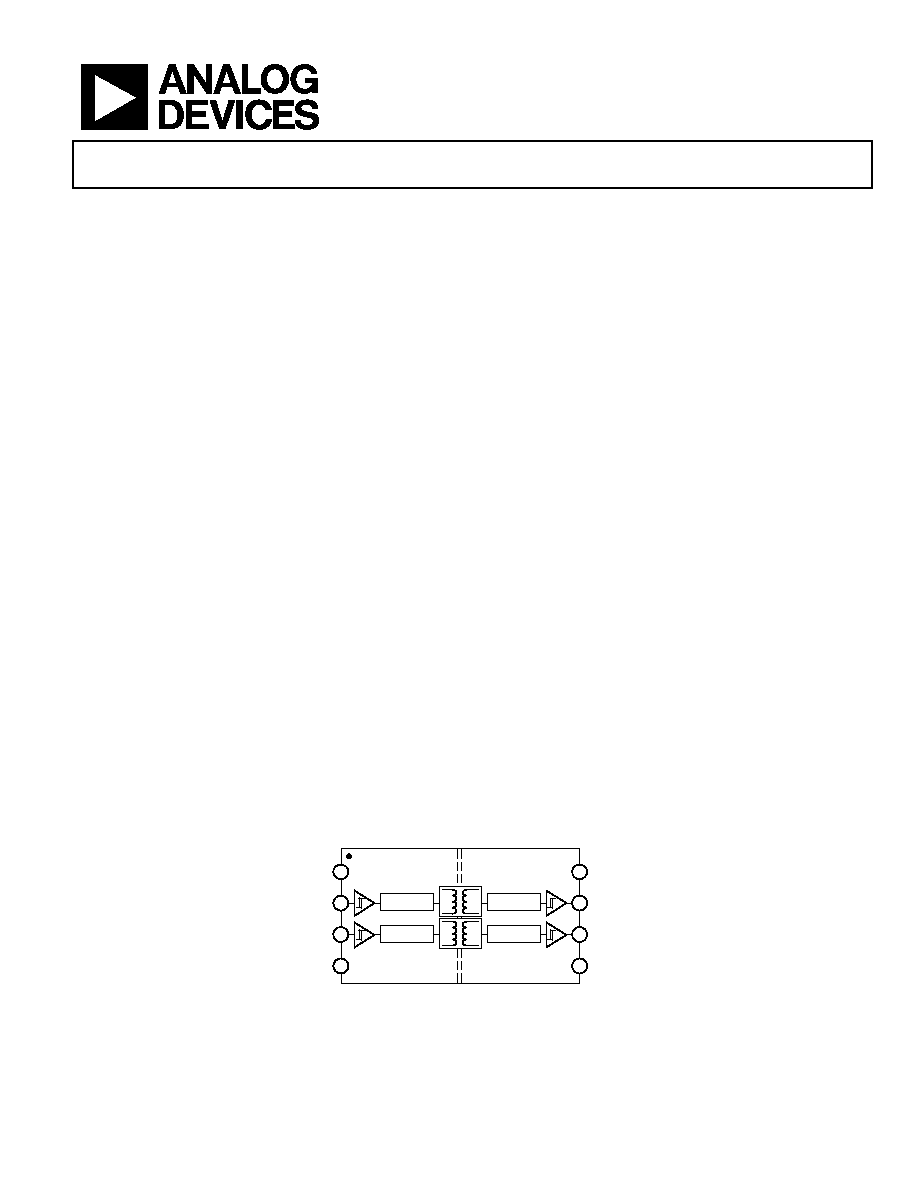
Dual-Channel Digital Isolator
ADuM1210
Rev. 0
Information furnished by Analog Devices is believed to be accurate and reliable. However, no
responsibility is assumed by Analog Devices for its use, nor for any infringements of patents or other
rights of third parties that may result from its use. Specifications subject to change without notice. No
license is granted by implication or otherwise under any patent or patent rights of Analog Devices.
Trademarks and registered trademarks are the property of their respective owners.
One Technology Way, P.O. Box 9106, Norwood, MA 02062-9106, U.S.A.
Tel: 781.329.4700
www.analog.com
Fax: 781.461.3113
© 2005 Analog Devices, Inc. All rights reserved.
FEATURES
Narrow body, 8-lead SOIC
Low power operation
5 V operation
1.1 mA per channel maximum @ 0 Mbps to 2 Mbps
3.7 mA per channel maximum @ 10 Mbps
3 V operation
0.8 mA per channel maximum @ 0 Mbps to 2 Mbps
2.2 mA per channel maximum @ 10 Mbps
3 V/5 V level translation
High temperature operation: 105°C
High data rate: dc to 25 Mbps (NRZ)
Precise timing characteristics
3 ns maximum pulse width distortion
3 ns maximum channel-to-channel matching
High common-mode transient immunity: > 25 kV/s
Safety and regulatory approvals
UL recognition
2500 V rms for 1 minute per UL 1577
CSA component acceptance notice #5A
VDE certificate of conformity
DIN EN 60747-5-2 (VDE 0884 Part 2): 2003-01
DIN EN 60950 (VDE 0805): 2001-12; DIN EN 60950: 2000
V
IORM
= 560 V peak
APPLICATIONS
Size-critical multichannel isolation
SPI® interface/data converter isolation
RS-232/RS-422/RS-485 transceiver isolation
Digital field bus isolation
GENERAL DESCRIPTION
The ADuM1210 is a dual-channel, digital isolator based on
Analog Devices' iCoupler® technology. Combining high speed
CMOS and monolithic transformer technology, this isolation
component provides outstanding performance characteristics
superior to alternatives such as optocoupler devices.
By avoiding the use of LEDs and photodiodes, iCoupler devices
remove the design difficulties commonly associated with
optocouplers. The typical optocoupler concerns regarding
uncertain current transfer ratios, nonlinear transfer functions,
and temperature and lifetime effects are eliminated with the
simple, iCoupler digital interfaces and stable performance
characteristics. The need for external drivers and other discrete
components is eliminated with iCoupler products.
Furthermore, iCoupler devices consume one-tenth to one-sixth
the power of optocouplers at comparable signal data rates.
The ADuM1210 isolator provides two independent isolation
channels operable with the supply voltage on either side ranging
from 2.7 V to 5.5 V. This provides compatibility with lower
voltage systems as well as enabling a voltage translation
functionality across the isolation barrier. In addition, the
ADuM1210 provides low pulse width distortion (<3 ns) and
tight channel-to-channel matching (<3 ns). Unlike other
optocoupler alternatives, the ADuM1210 isolator has a patented
refresh feature that ensures dc correctness in the absence of
input logic transitions and during power-up/power-down
conditions. Furthermore, as an alternative to the ADuM1200
dual-channel, digital isolator that defaults to an output high
condition, the ADuM1210's outputs default to a logic low state
when input power is off.
FUNCTIONAL BLOCK DIAGRAM
ENCODE
DECODE
ENCODE
DECODE
V
DD1
V
IA
V
IB
GND
1
V
DD2
V
OA
V
OB
GND
2
1
2
3
4
8
7
6
5
05459-
001
Figure 1.

ADuM1210
Rev. 0 | Page 2 of 16
TABLE OF CONTENTS
Features .............................................................................................. 1
Applications....................................................................................... 1
General Description ......................................................................... 1
Functional Block Diagram .............................................................. 1
Revision History ............................................................................... 2
Specifications..................................................................................... 3
Electrical Characteristics--5 V Operation................................ 3
Electrical Characteristics--3 V Operation................................ 5
Electrical Characteristics--Mixed 5 V/3 V or 3 V/5 V
Operation....................................................................................... 7
Package Characteristics ............................................................... 9
Regulatory Information............................................................... 9
Insulation and Safety-Related Specifications............................ 9
DIN EN 60747-5-2 (VDE 0884 Part 2) Insulation
Characteristics ............................................................................ 10
Recommended Operating Conditions .................................... 10
Absolute Maximum Ratings ......................................................... 11
ESD Caution................................................................................ 11
Pin Configuration and Function Descriptions........................... 12
Typical Performance Characteristics ........................................... 13
Application Information................................................................ 14
PC Board Layout ........................................................................ 14
Propagation Delay-Related Parameters................................... 14
DC Correctness and Magnetic Field Immunity........................... 14
Power Consumption .................................................................. 15
Outline Dimensions ....................................................................... 16
Ordering Guide .......................................................................... 16
REVISION HISTORY
7/05--Revision 0: Initial Version
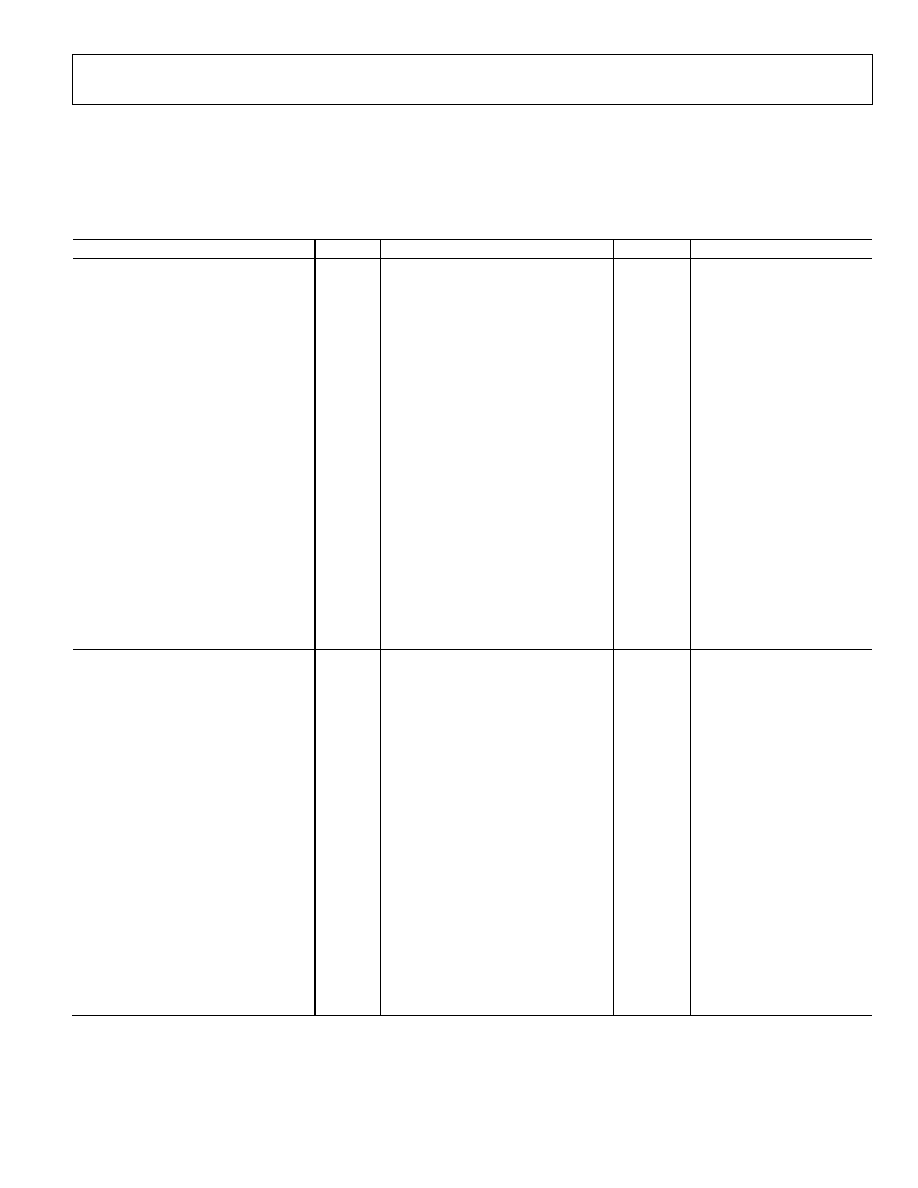
ADuM1210
Rev. 0 | Page 3 of 16
SPECIFICATIONS
ELECTRICAL CHARACTERISTICS--5 V OPERATION
All voltages are relative to their respective ground. 4.5 V V
DD1
5.5 V, 4.5 V V
DD2
5.5 V. All min/max specifications apply over the
entire recommended operating range, unless otherwise noted. All typical specifications are at T
A
= 25°C, V
DD1
= V
DD2
= 5 V.
Table 1.
Parameter
Symbol
Min
Typ
Max
Unit
Test Conditions
DC SPECIFICATIONS
Input Supply Current, per Channel,
Quiescent
I
DDI (Q)
0.50
0.60
mA
Output Supply Current, per Channel,
Quiescent
I
DDO (Q)
0.19
0.25
mA
Total Supply Current, Two Channels
1
DC to 2 Mbps
V
DD1
Supply Current
I
DD1 (Q)
1.1
1.4
mA
DC to 1 MHz logic signal freq.
V
DD2
Supply Current
I
DD2 (Q)
0.5
0.8
mA
DC to 1 MHz logic signal freq.
10 Mbps
V
DD1
Supply Current
I
DD1 (10)
4.3
5.5
mA
5 MHz logic signal freq.
V
DD2
Supply Current
I
DD2 (10)
1.3
2.0
mA
5 MHz logic signal freq.
Input Currents
I
IA
, I
IB
-10
+0.01
+10
A
0 V
IA
, V
IB
V
DD1
or V
DD2
Logic High Input Threshold
V
IH
0.7 V
DD1
, V
DD2
V
Logic Low Input Threshold
V
IL
0.3 V
DD1
, V
DD2
V
Logic High Output Voltages
V
OAH
V
DD1
/
V
DD2
- 0.1
5.0
V
I
Ox
= -20 A, V
Ix
= V
IxH
V
OBH
V
DD1
/
V
DD2
- 0.5
4.8
V
I
Ox
= -4 mA, V
Ix
= V
IxH
Logic Low Output Voltages
V
OAL
0.0
0.1
V
I
Ox
= 20 A, V
Ix
= V
IxL
V
OBL
0.04
0.1
V
I
Ox
= 400 A, V
Ix
= V
IxL
0.2
0.4
V
I
Ox
= 4 mA, V
Ix
= V
IxL
SWITCHING SPECIFICATIONS
Minimum Pulse Width
2
PW
100
ns
C
L
= 15 pF, CMOS signal levels
Maximum Data Rate
3
10
Mbps
C
L
= 15 pF, CMOS signal levels
Propagation Delay
4
t
PHL
, t
PLH
20
50
ns
C
L
= 15 pF, CMOS signal levels
Pulse Width Distortion, |t
PLH
- t
PHL
|
4
PWD
3
ns
C
L
= 15 pF, CMOS signal levels
Change vs. Temperature
5
ps/°C
C
L
= 15 pF, CMOS signal levels
Propagation Delay Skew
5
t
PSK
15
ns
C
L
= 15 pF, CMOS signal levels
Channel-to-Channel Matching,
Codirectional Channels
6
t
PSKCD
3
ns
C
L
= 15 pF, CMOS signal levels
Channel-to-Channel Matching,
Opposing-Directional Channels
6
t
PSKOD
15
ns
C
L
= 15 pF, CMOS signal levels
Output Rise/Fall Time (10% to 90%)
t
R
/t
F
2.5
ns
C
L
= 15 pF, CMOS signal levels
Common-Mode Transient Immunity
at Logic High Output
7
|CM
H
|
25
35
kV/s
V
Ix
= V
DD1
, V
DD2
, V
CM
= 1000 V,
transient magnitude = 800 V
Common-Mode Transient Immunity
at Logic Low Output
7
|CM
L
|
25
35
kV/s
V
Ix
= 0 V, V
CM
= 1000 V,
transient magnitude = 800 V
Refresh Rate
f
r
1.2
Mbps
Input Dynamic Supply Current,
per Channel
8
I
DDI (D)
0.19
mA/Mbps
Output Dynamic Supply Current,
per Channel
8
I
DDO (D)
0.05
mA/Mbps
Notes on next page.

ADuM1210
Rev. 0 | Page 4 of 16
1
Supply current values are for both channels running at identical data rates. Output supply current values are specified with no output load present. The supply current
associated with an individual channel operating at a given data rate may be calculated as described in the Power Consumption section. See Figure 4 to Figure 6 for
information on per-channel supply current as a function of data rate for unloaded and loaded conditions. See Figure 7 through Figure 8 for total I
DD1
and I
DD2
supply
currents as a function of data rate.
2
The minimum pulse width is the shortest pulse width at which the specified pulse width distortion is guaranteed.
3
The maximum data rate is the fastest data rate at which the specified pulse width distortion is guaranteed.
4
t
PHL
propagation delay is measured from the 50% level of the falling edge of the V
Ix
signal to the 50% level of the falling edge of the V
Ox
signal. t
PLH
propagation delay is
measured from the 50% level of the rising edge of the V
Ix
signal to the 50% level of the rising edge of the V
Ox
signal.
5
t
PSK
is the magnitude of the worst-case difference in t
PHL
and/or t
PLH
that is measured between units at the same operating temperature, supply voltages, and output
load within the recommended operating conditions.
6
Codirectional channel-to-channel matching is the absolute value of the difference in propagation delays between any two channels with inputs on the same side of
the isolation barrier. Opposing-directional channel-to-channel matching is the absolute value of the difference in propagation delays between any two channels with
inputs on opposing sides of the isolation barrier.
7
CM
H
is the maximum common-mode voltage slew rate that can be sustained while maintaining V
O
> 0.8 V
DD2
. CM
L
is the maximum common-mode voltage slew rate
that can be sustained while maintaining V
O
< 0.8 V. The common-mode voltage slew rates apply to both rising and falling common-mode voltage edges. The transient
magnitude is the range over which the common mode is slewed.
8
Dynamic supply current is the incremental amount of supply current required for a 1 Mbps increase in the signal data rate. See Figure 4 through Figure 6 for
information on per-channel supply current for unloaded and loaded conditions. See the Power Consumption section for guidance on calculating per-channel supply
current for a given data rate.
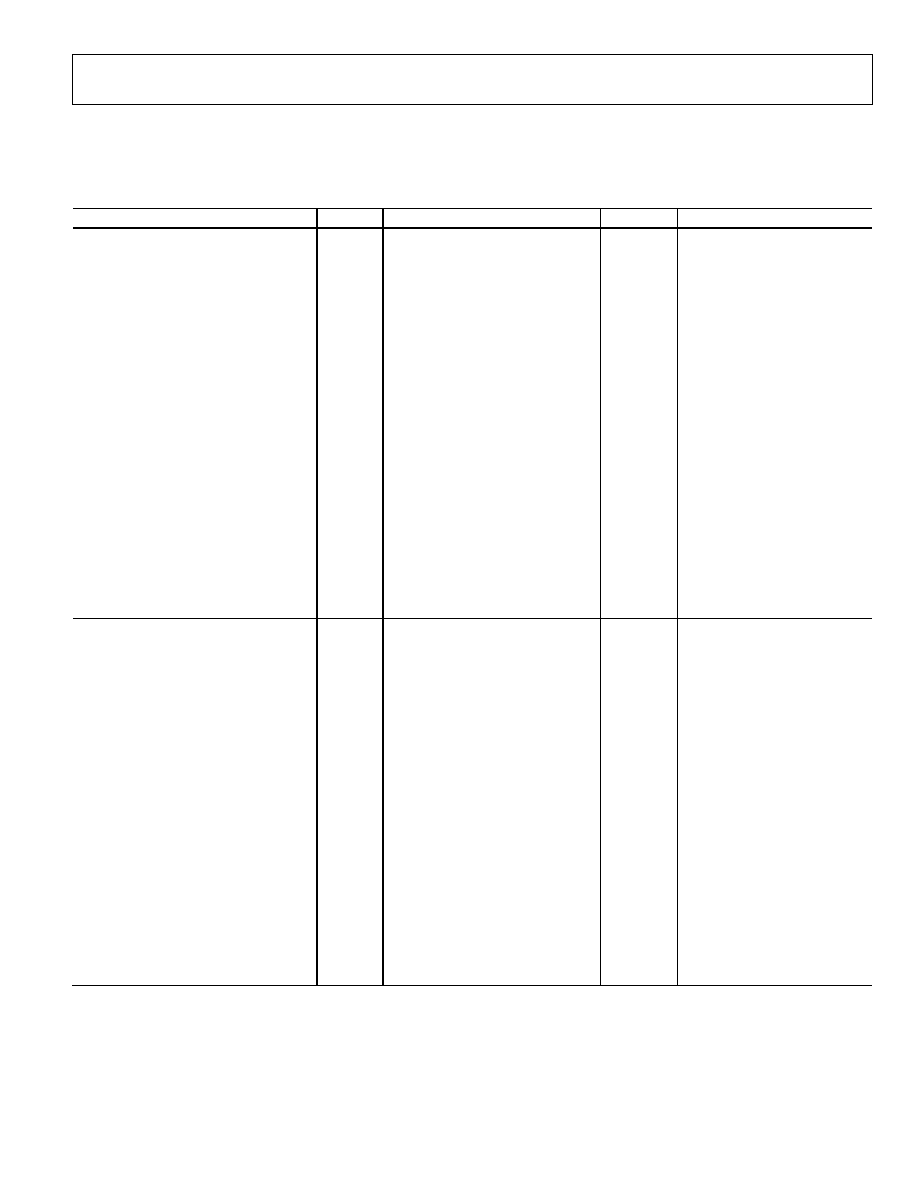
ADuM1210
Rev. 0 | Page 5 of 16
ELECTRICAL CHARACTERISTICS--3 V OPERATION
All voltages are relative to their respective ground. 2.7 V V
DD1
3.6 V, 2.7 V V
DD2
3.6 V. All min/max specifications apply over the
entire recommended operating range, unless otherwise noted. All typical specifications are at T
A
= 25°C, V
DD1
= V
DD2
= 3.0 V.
Table 2.
Parameter
Symbol
Min
Typ
Max
Unit
Test Conditions
DC SPECIFICATIONS
Input Supply Current, per Channel,
Quiescent
I
DDI (Q)
0.26
0.35
mA
Output Supply Current, per Channel,
Quiescent
I
DDO (Q)
0.11
0.20
mA
Total Supply Current, Two Channels
1
DC to 2 Mbps
V
DD1
Supply Current
I
DD1 (Q)
0.6
1.0
mA
DC to 1 MHz logic signal freq.
V
DD2
Supply Current
I
DD2 (Q)
0.2
0.6
mA
DC to 1 MHz logic signal freq.
10
Mbps
V
DD1
Supply Current
I
DD1 (10)
2.2
3.4
mA
5 MHz logic signal freq.
V
DD2
Supply Current
I
DD2 (10)
0.7
1.1
mA
5 MHz logic signal freq.
Input Currents
I
IA
, I
IB
-10
0.01
10
A
0 V
IA
, V
IB
, V
DD1
or V
DD2
Logic High Input Threshold
V
IH
0.7 V
DD1
, V
DD2
V
Logic Low Input Threshold
V
IL
0.3 V
DD1
, V
DD2
Logic High Output Voltages
V
OAH
V
DD1
/
V
DD2
- 0.1
3.0
V
I
Ox
= -20 A, V
Ix
= V
IxH
V
OBH
V
DD1
/
V
DD2
- 0.5
2.8
V
I
Ox
= -4 mA, V
Ix
= V
IxH
Logic Low Output Voltages
V
OAL
0.0
0.1
V
I
Ox
= 20 A, V
Ix
= V
IxL
V
OBL
0.04
0.1
V
I
Ox
= 400 A, V
Ix
= V
IxL
0.2
0.4
V
I
Ox
= 4 mA, V
Ix
= V
IxL
SWITCHING SPECIFICATIONS
Minimum Pulse Width
2
PW
100
ns
C
L
= 15 pF, CMOS signal levels
Maximum Data Rate
3
10
Mbps
C
L
= 15 pF, CMOS signal levels
Propagation Delay
4
t
PHL
, t
PLH
20
60
ns
C
L
= 15 pF, CMOS signal levels
Pulse Width Distortion, |t
PLH
-t
PHL
|
4
PWD
3
ns
C
L
= 15 pF, CMOS signal levels
Change vs. Temperature
5
ps/°C
C
L
= 15 pF, CMOS signal levels
Propagation Delay Skew
5
t
PSK
22
ns
C
L
= 15 pF, CMOS signal levels
Channel-to-Channel Matching,
Codirectional Channels
6
t
PSKCD
3
ns
C
L
= 15 pF, CMOS signal levels
Channel-to-Channel Matching,
Opposing-Directional Channels
6
t
PSKOD
22
ns
C
L
= 15 pF, CMOS signal levels
Output Rise/Fall Time (10% to 90%)
t
R
/t
F
3.0
ns
C
L
= 15 pF, CMOS signal levels
Common Mode Transient Immunity
at Logic High Output
7
|CM
H
|
25
35
kV/s
V
Ix
= V
DD1
, V
DD2
, V
CM
= 1000 V,
transient magnitude = 800 V
Common Mode Transient Immunity
at Logic Low Output
7
|CM
L
|
25
35
kV/s
V
Ix
= 0 V, V
CM
= 1000 V,
transient magnitude = 800 V
Refresh Rate
f
r
1.1
Mbps
Input Dynamic Supply Current,
per Channel
8
I
DDI (D)
0.10
mA/Mbps
Output Dynamic Supply Current,
per Channel
8
I
DDO (D)
0.03
mA/Mbps
Notes on next page.

ADuM1210
Rev. 0 | Page 6 of 16
1
The supply current values for both channels are combined when running at identical data rates. Output supply current values are specified with no output load
present. The supply current associated with an individual channel operating at a given data rate may be calculated as described in the Power Consumption section. See
Figure 4 through Figure 6 for information on per-channel supply current as a function of data rate for unloaded and loaded conditions. See Figure 7 and Figure 8 for
total I
DD1
and I
DD2
supply currents as a function of data rate.
2
The minimum pulse width is the shortest pulse width at which the specified pulse width distortion is guaranteed.
3
The maximum data rate is the fastest data rate at which the specified pulse width distortion is guaranteed.
4
t
PHL
propagation delay is measured from the 50% level of the falling edge of the V
Ix
signal to the 50% level of the falling edge of the V
Ox
signal. t
PLH
propagation delay is
measured from the 50% level of the rising edge of the V
Ix
signal to the 50% level of the rising edge of the V
Ox
signal.
5
t
PSK
is the magnitude of the worst-case difference in t
PHL
and/or t
PLH
that is measured between units at the same operating temperature, supply voltages, and output
load within the recommended operating conditions.
6
Codirectional channel-to-channel matching is the absolute value of the difference in propagation delays between any two channels with inputs on the same side of
the isolation barrier. Opposing-directional channel-to-channel matching is the absolute value of the difference in propagation delays between any two channels with
inputs on opposing sides of the isolation barrier.
7
CM
H
is the maximum common-mode voltage slew rate that can be sustained while maintaining V
O
> 0.8 V
DD2
. CM
L
is the maximum common-mode voltage slew rate
that can be sustained while maintaining V
O
< 0.8 V. The common-mode voltage slew rates apply to both rising and falling common-mode voltage edges. The transient
magnitude is the range over which the common mode is slewed.
8
Dynamic supply current is the incremental amount of supply current required for a 1 Mbps increase in the signal data rate. See Figure 4 through Figure 6 for
information on per-channel supply current for unloaded and loaded conditions. See the Power Consumption section for guidance on calculating per-channel supply
current for a given data rate.
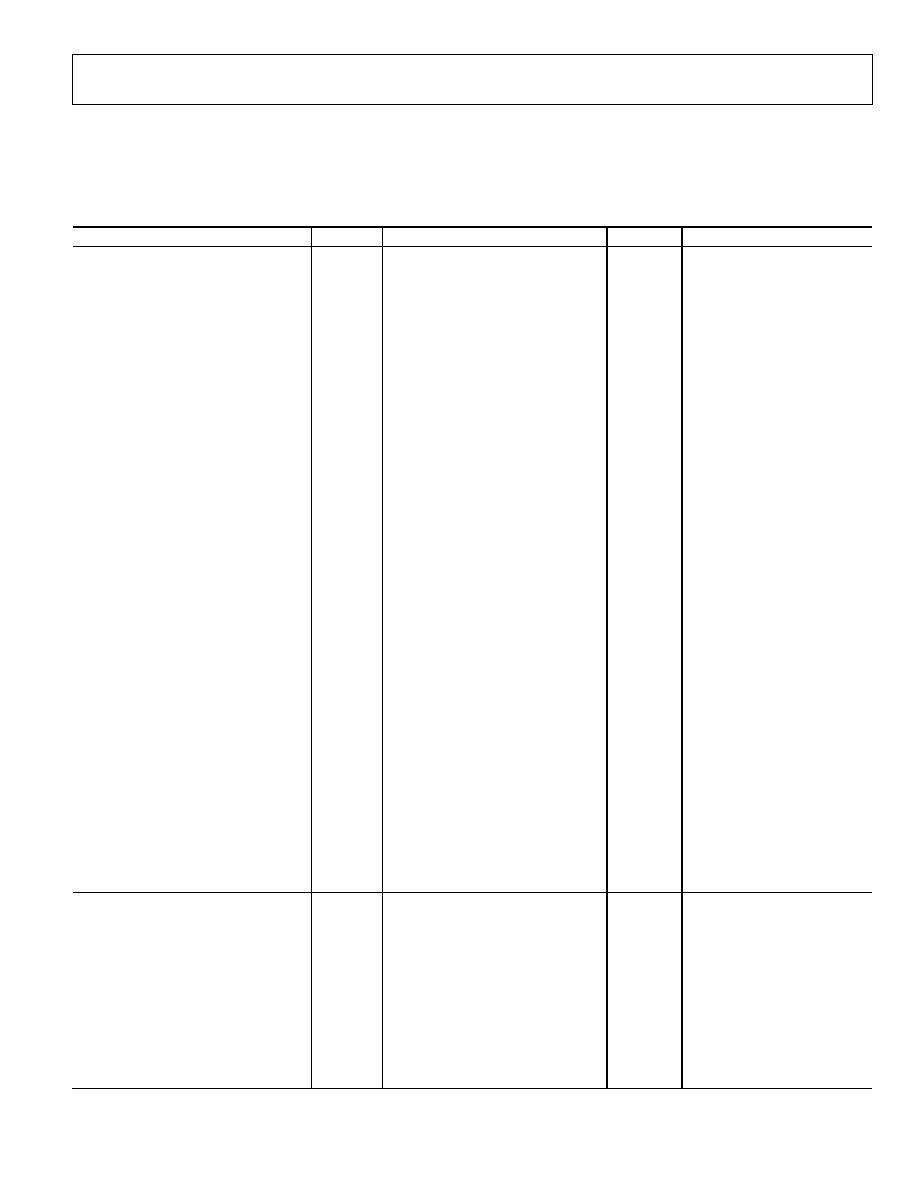
ADuM1210
Rev. 0 | Page 7 of 16
ELECTRICAL CHARACTERISTICS--MIXED 5 V/3 V OR 3 V/5 V OPERATION
All voltages are relative to their respective ground. 5 V/3 V operation: 4.5 V V
DD1
5.5 V, 2.7 V V
DD2
3.6 V. 3 V/5 V operation: 2.7 V
V
DD1
3.6 V, 4.5 V V
DD2
5.5 V. All min/max specifications apply over the entire recommended operating range, unless otherwise
noted. All typical specifications are at T
A
= 25°C; V
DD1
= 3.0 V, V
DD2
= 5.0 V; or V
DD1
= 5.0 V, V
DD2
= 3.0 V.
Table 3.
Parameter
Symbol
Min
Typ
Max
Unit
Test Conditions
DC SPECIFICATIONS
Input Supply Current, per Channel,
Quiescent
I
DDI (Q)
mA
5 V/3 V Operation
0.50
0.6
mA
3 V/5 V Operation
0.26
0.35
mA
Output Supply Current, per Channel,
Quiescent
I
DDO (Q)
mA
5 V/3 V Operation
0.11
0.20
mA
3 V/5 V Operation
0.19
0.25
mA
Total Supply Current, Two Channels
1
DC to 2 Mbps
V
DD1
Supply Current
I
DD1 (Q)
5 V/3 V Operation
1.1
1.4
mA
DC to 1 MHz logic signal freq.
3 V/5 V Operation
0.6
1.0
mA
DC to 1 MHz logic signal freq.
V
DD2
Supply Current
I
DD2 (Q)
5 V/3 V Operation
0.2
0.6
mA
DC to 1 MHz logic signal freq.
3 V/5 V Operation
0.5
0.8
mA
DC to 1 MHz logic signal freq.
10
Mbps
V
DD1
Supply Current
I
DD1 (10)
5 V/3 V Operation
4.3
5.5
mA
5 MHz logic signal freq.
3 V/5 V Operation
2.2
3.4
mA
5 MHz logic signal freq.
V
DD2
Supply Current
I
DD2 (10)
5 V/3 V Operation
0.7
1.1
mA
5 MHz logic signal freq.
3 V/5 V Operation
1.3
2.0
mA
5 MHz logic signal freq.
Input Currents
I
IA
, I
IB
-10
0.01
10
A
0 V
IA
, V
IB
V
DD1
or V
DD2
Logic High Input Threshold
V
IH
0.7 V
DD1
, V
DD2
V
Logic Low Input Threshold
V
IL
0.3 V
DD1
, V
DD2
V
5 V/3 V Operation
0.8
V
3 V/5 V Operation
0.4
V
Logic High Output Voltages
V
OAH
, V
OBH
V
DD1
/
V
DD2
- 0.1
V
DD1
,
V
DD2
V
I
Ox
= -20 A, V
Ix
= V
IxH
V
DD1
/
V
DD2
- 0.5
V
DD1
,
V
DD2
- 0.2
V
I
Ox
= -4 mA, V
Ix
= V
IxH
Logic Low Output Voltages
V
OAL
, V
OBL
0.0
0.1
V
I
Ox
= 20 A, V
Ix
= V
IxL
0.04
0.1
V
I
Ox
= 400 A, V
Ix
= V
IxL
0.2
0.4
V
I
Ox
= 4 mA, V
Ix
= V
IxL
SWITCHING SPECIFICATIONS
Minimum Pulse Width
2
PW
100
ns
C
L
= 15 pF, CMOS signal levels
Maximum Data Rate
3
10
Mbps
C
L
= 15 pF, CMOS signal levels
Propagation Delay
4
t
PHL
, t
PLH
15
55
ns
C
L
= 15 pF, CMOS signal levels
Pulse Width Distortion, |t
PLH
- t
PHL
|
4
PWD
3
ns
C
L
= 15 pF, CMOS signal levels
Change vs. Temperature
5
ps/°C
C
L
= 15 pF, CMOS signal levels
Propagation Delay Skew
5
t
PSK
22
ns
C
L
= 15 pF, CMOS signal levels
Channel-to-Channel Matching,
Codirectional Channels
6
t
PSKCD
3
ns
C
L
= 15 pF, CMOS signal levels
Channel-to-Channel Matching,
Opposing-Directional Channels
6
t
PSKOD
22
ns
C
L
= 15 pF, CMOS signal levels
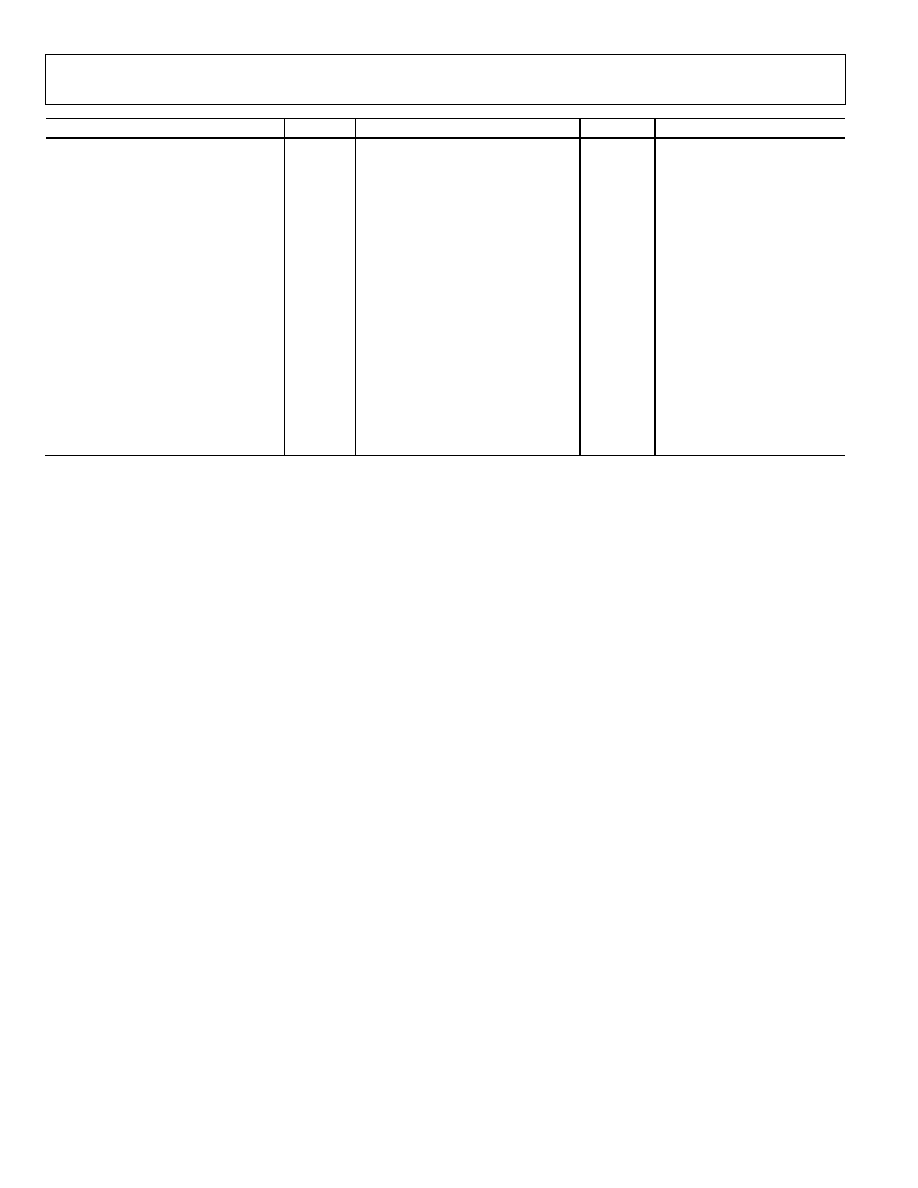
ADuM1210
Rev. 0 | Page 8 of 16
Parameter
Symbol
Min
Typ
Max
Unit
Test Conditions
Output Rise/Fall Time (10% to 90%)
t
R
/t
f
C
L
= 15 pF, CMOS signal levels
5 V/3 V Operation
3.0
ns
3 V/5 V Operation
2.5
ns
Common-Mode Transient Immunity
at Logic High Output
7
|CM
H
|
25
35
kV/s
V
Ix
= V
DD1
, V
DD2
, V
CM
= 1000 V,
transient magnitude = 800 V
Common-Mode Transient Immunity
at Logic Low Output
7
|CM
L
|
25
35
kV/s
V
Ix
= 0 V, V
CM
= 1000 V,
transient magnitude = 800 V
Refresh Rate
f
r
5 V/3 V Operation
1.2
Mbps
3 V/5 V Operation
1.1
Mbps
Input Dynamic Supply Current,
per Channel
8
I
DDI (D)
5 V/3 V Operation
0.19
mA/Mbps
3 V/5 V Operation
0.10
mA/Mbps
Output Dynamic Supply Current,
per Channel
8
I
DDI (D)
5 V/3 V Operation
0.03
mA/Mbps
3 V/5 V Operation
0.05
mA/Mbps
1
The supply current values for both channels are combined when running at identical data rates. Output supply current values are specified with no output load
present. The supply current associated with an individual channel operating at a given data rate may be calculated as described in the Power Consumption section. See
Figure 4 through Figure 6 for information on per-channel supply current as a function of data rate for unloaded and loaded conditions. See Figure 7 and Figure 8 for
total I
DD1
and I
DD2
supply currents as a function of data rate.
2
The minimum pulse width is the shortest pulse width at which the specified pulse width distortion is guaranteed.
3
The maximum data rate is the fastest data rate at which the specified pulse width distortion is guaranteed.
4
t
PHL
propagation delay is measured from the 50% level of the falling edge of the V
Ix
signal to the 50% level of the falling edge of the V
Ox
signal. t
PLH
propagation delay is
measured from the 50% level of the rising edge of the V
Ix
signal to the 50% level of the rising edge of the V
Ox
signal.
5
t
PSK
is the magnitude of the worst-case difference in t
PHL
and/or t
PLH
that is measured between units at the same operating temperature, supply voltages, and output
load within the recommended operating conditions.
6
Codirectional channel-to-channel matching is the absolute value of the difference in propagation delays between any two channels with inputs on the same side of
the isolation barrier. Opposing-directional channel-to-channel matching is the absolute value of the difference in propagation delays between any two channels with
inputs on opposing sides of the isolation barrier.
7
CM
H
is the maximum common-mode voltage slew rate that can be sustained while maintaining V
O
> 0.8 V
DD2
. CM
L
is the maximum common-mode voltage slew rate
that can be sustained while maintaining V
O
< 0.8 V. The common-mode voltage slew rates apply to both rising and falling common-mode voltage edges. The transient
magnitude is the range over which the common mode is slewed.
8
Dynamic supply current is the incremental amount of supply current required for a 1 Mbps increase in the signal data rate. See Figure 4 through Figure 6 for
information on per-channel supply current for unloaded and loaded conditions. See the Power Consumption section for guidance on calculating per-channel supply
current for a given data rate.
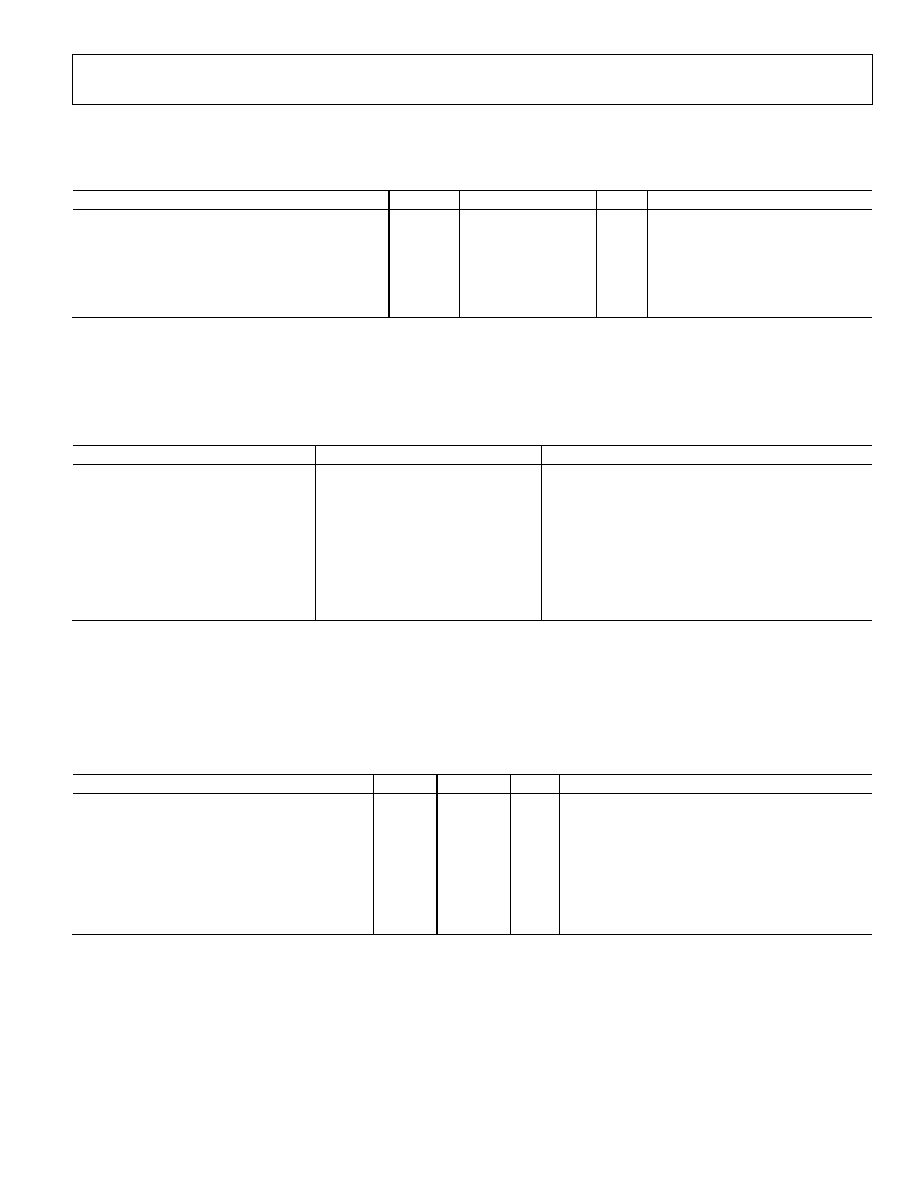
ADuM1210
Rev. 0 | Page 9 of 16
PACKAGE CHARACTERISTICS
Table 4.
Parameter
Symbol
Min
Typ
Max
Unit
Test Conditions
Resistance (Input-to-Output)
1
R
I-O
10
12
Capacitance (Input-to-Output)
1
C
I-O
1.0
pF
f = 1 MHz
Input Capacitance
C
I
4.0
pF
IC Junction-to-Case Thermal Resistance, Side 1
JCI
46
°C/W
Thermocouple located at center
of package underside
IC Junction-to-Case Thermal Resistance, Side 2
JCO
41
°C/W
1
The device is considered a 2-terminal device; Pin 1, Pin 2, Pin 3, and Pin 4 are shorted together, and Pin 5, Pin 6, Pin 7, and Pin 8 are shorted together.
REGULATORY INFORMATION
The ADuM1210 has been approved by the following organizations:
Table 5.
UL
CSA
VDE
Recognized under 1577 Component
Recognition Program
1
Approved under CSA Component
Acceptance Notice #5A
Certified according to
DIN EN 60747-5-2 (VDE 0884 Part 2):2003-01
2
2500 V rms isolation voltage
Basic insulation, 560 V peak
Complies with DIN EN 60747-5-2 (VDE 0884
Part 2):2003-01, DIN EN 60950 (VDE 0805):2001-12;
EN 60950:2000, Reinforced insulation, 560 V peak
File E214100
File 205078
File 2471900-4880-0001
1
In accordance with UL1577, each ADuM1210 is proof-tested by applying an insulation test voltage 3000 V rms for 1 second (current leakage detection limit = 5 A).
2
In accordance with DIN EN 60747-5-2, each ADuM1210 is proof-tested by applying an insulation test voltage 1050 V peak for 1 second (partial discharge detection
limit = 5 pC).
INSULATION AND SAFETY-RELATED SPECIFICATIONS
Table 6.
Parameter
Symbol
Value
Unit
Conditions
Rated Dielectric Insulation Voltage
2500
V rms
1-minute duration
Minimum External Air Gap (Clearance)
L(I01)
4.90 min
mm
Measured from input terminals to output terminals,
shortest distance through air
Minimum External Tracking (Creepage)
L(I02)
4.01 min
mm
Measured from input terminals to output terminals,
shortest distance path along body
Minimum Internal Gap (Internal Clearance)
0.017 min
mm
Insulation distance through insulation
Tracking Resistance (Comparative Tracking Index)
CTI
>175
V
DIN IEC 112/VDE 0303 Part 1
Isolation Group
IIIa
Material Group (DIN VDE 0110, 1/89, Table 1)
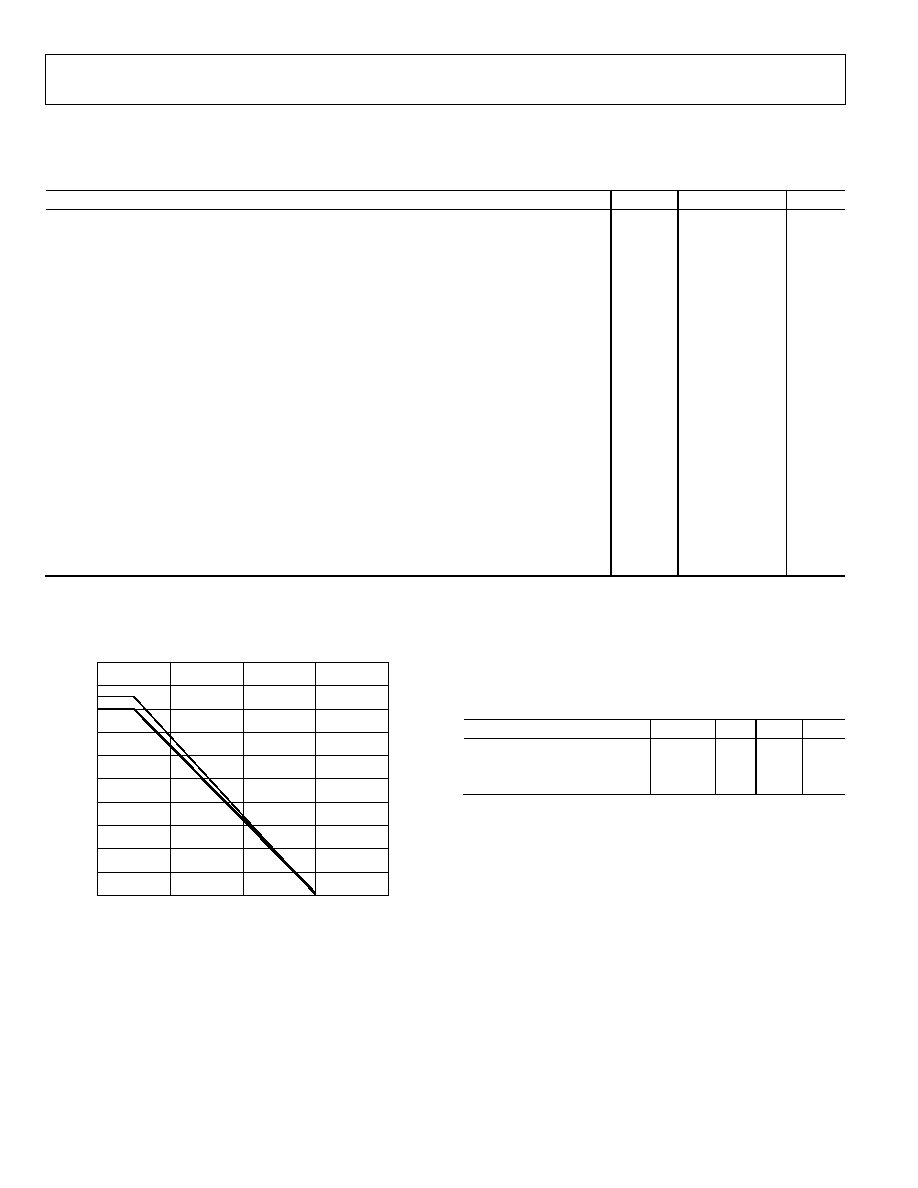
ADuM1210
Rev. 0 | Page 10 of 16
DIN EN 60747-5-2 (VDE 0884 PART 2) INSULATION CHARACTERISTICS
Table 7.
Description
Symbol
Characteristic
Unit
Installation Classification per DIN VDE 0110
For Rated Mains Voltage 150 V rms
I-IV
For Rated Mains Voltage 300 V rms
I-III
For Rated Mains Voltage 400 V rms
I-II
Climatic Classification
40/105/21
Pollution Degree (DIN VDE 0110, Table 1)
2
Maximum Working Insulation Voltage
V
IORM
560
V peak
Input-to-Output Test Voltage, Method b1
V
PR
1050
V peak
V
IORM
× 1.875 = V
PR
, 100% Production Test, t
m
= 1 sec, Partial Discharge < 5 pC
Input-to-Output Test Voltage, Method a
V
PR
After Environmental Tests Subgroup 1
V
IORM
× 1.6 = V
PR
, t
m
= 60 sec, Partial Discharge < 5 pC
896
V peak
After Input and/or Safety Test Subgroup 2/3
672
V
IORM
× 1.2 = V
PR
, t
m
= 60 sec, Partial Discharge < 5 pC
Highest Allowable Overvoltage (Transient Overvoltage, t
TR
= 10 sec)
V
TR
4000
V peak
Safety-Limiting Values (maximum value allowed in the event of a failure; also see Figure 2)
Case Temperature
T
S
150
°C
Side 1 Current
I
S1
160
mA
Side 2 Current
I
S2
170
mA
Insulation Resistance at T
S
, V
IO
= 500 V
R
S
>10
9
Note that the "*" marking on the package denotes DIN EN 60747-5-2 approval for a 560 V peak working voltage.
This isolator is suitable for basic isolation only within the safety limit data. Maintenance of the safety data is ensured by protective circuits.
CASE TEMPERATURE (
°
C)
SAFETY-LIMITING CURRENT (mA)
0
0
200
180
100
80
60
40
20
50
100
150
200
SIDE #1
SIDE #2
05459-002
120
140
160
Figure 2. Thermal Derating Curve, Dependence of Safety Limiting Values on
Case Temperature, per DIN EN 60747-5-2
RECOMMENDED OPERATING CONDITIONS
Table 8.
Parameter
Symbol
Min
Max
Unit
Operating Temperature
T
A
-40
+105
°C
Supply Voltages
1
V
DD1
, V
DD2
2.7
5.5
V
Input Signal Rise and Fall Times
1.0
ms
1
All voltages are relative to their respective ground. See the DC Correctness and
Magnetic Field Immunity section for information on immunity to external
magnetic fields.
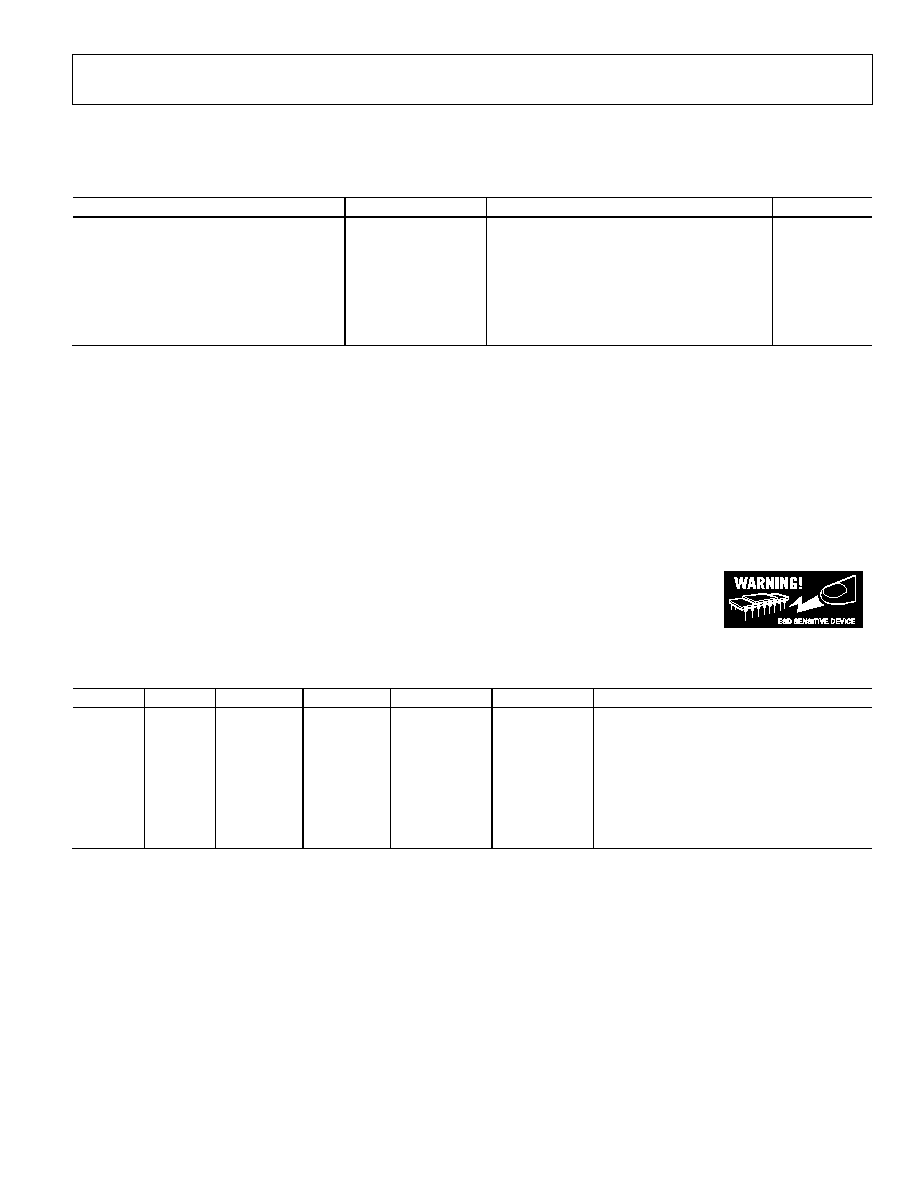
ADuM1210
Rev. 0 | Page 11 of 16
ABSOLUTE MAXIMUM RATINGS
Ambient temperature = 25°C, unless otherwise noted.
Table 9.
Parameter
Symbol
Min
Max
Unit
Storage Temperature
T
ST
-55
150
°C
Ambient Operating Temperature
T
A
-40
105
°C
Supply Voltages
1
V
DD1
, V
DD2
-0.5
7.0
V
Input Voltage
1
V
IA
, V
IB
-0.5
V
DDI
+ 0.5
V
Output Voltage
1
V
OA
, V
OB
-0.5
V
DDO
+ 0.5
V
Average Output Current, per Pin
2
I
O
-35
35
mA
Common-Mode Transients
3
-100
+100 kV/s
1
All voltages are relative to their respective ground.
2
See Figure 2 for maximum rated current values for various temperatures.
3
Refers to common-mode transients across the insulation barrier. Common-mode transients exceeding the Absolute Maximum Rating may cause latch-up or
permanent damage.
Stresses above those listed under Absolute Maximum Ratings may cause permanent damage to the device. This is a stress rating only;
Functional operation of the device at these or any other conditions above those listed in the operational sections of this specification is
not implied. Exposure to absolute maximum rating conditions for extended periods may affect device reliability.
ESD CAUTION
ESD (electrostatic discharge) sensitive device. Electrostatic charges as high as 4000 V readily accumulate on
the human body and test equipment and can discharge without detection. Although this product features
proprietary ESD protection circuitry, permanent damage may occur on devices subjected to high energy
electrostatic discharges. Therefore, proper ESD precautions are recommended to avoid performance
degradation or loss of functionality.
Table 10. ADuM1210 Truth Table (Positive Logic)
V
IA
Input
V
IB
Input
V
DD1
State
V
DD2
State
V
OA
Output
V
OB
Output
Notes
H
H
Powered
Powered
H
H
L
L
Powered
Powered
L
L
H
L
Powered
Powered
H
L
L
H
Powered
Powered
L
H
X
X
Unpowered
Powered
L
L
Outputs return to the input state within 1 s
of V
DDI
power restoration.
X
X
Powered
Unpowered
Indeterminate
Indeterminate
Outputs return to the input state within 1 s
of V
DDO
power restoration.

ADuM1210
Rev. 0 | Page 12 of 16
PIN CONFIGURATION AND FUNCTION DESCRIPTIONS
1
8
2
7
3
6
4
5
ADuM1210
TOP VIEW
(Not to Scale)
05459-003
V
DD1
V
IA
V
IB
GND
1
V
DD2
V
OA
V
OB
GND
2
Figure 3. Pin Configuration
Table 11. Pin Function Descriptions
Pin No.
Mnemonic
Description
1
V
DD1
Supply Voltage for Isolator Side 1, 2.7 V to 5.5 V.
2
V
IA
Logic Input A.
3
V
IB
Logic Input B.
4
GND
1
Ground 1. Ground reference for isolator Side 1.
5
GND
2
Ground 2. Ground reference for isolator Side 2.
6
V
OB
Logic Output B.
7
V
OA
Logic Output A.
8
V
DD2
Supply Voltage for Isolator Side 2, 2.7 V to 5.5 V.
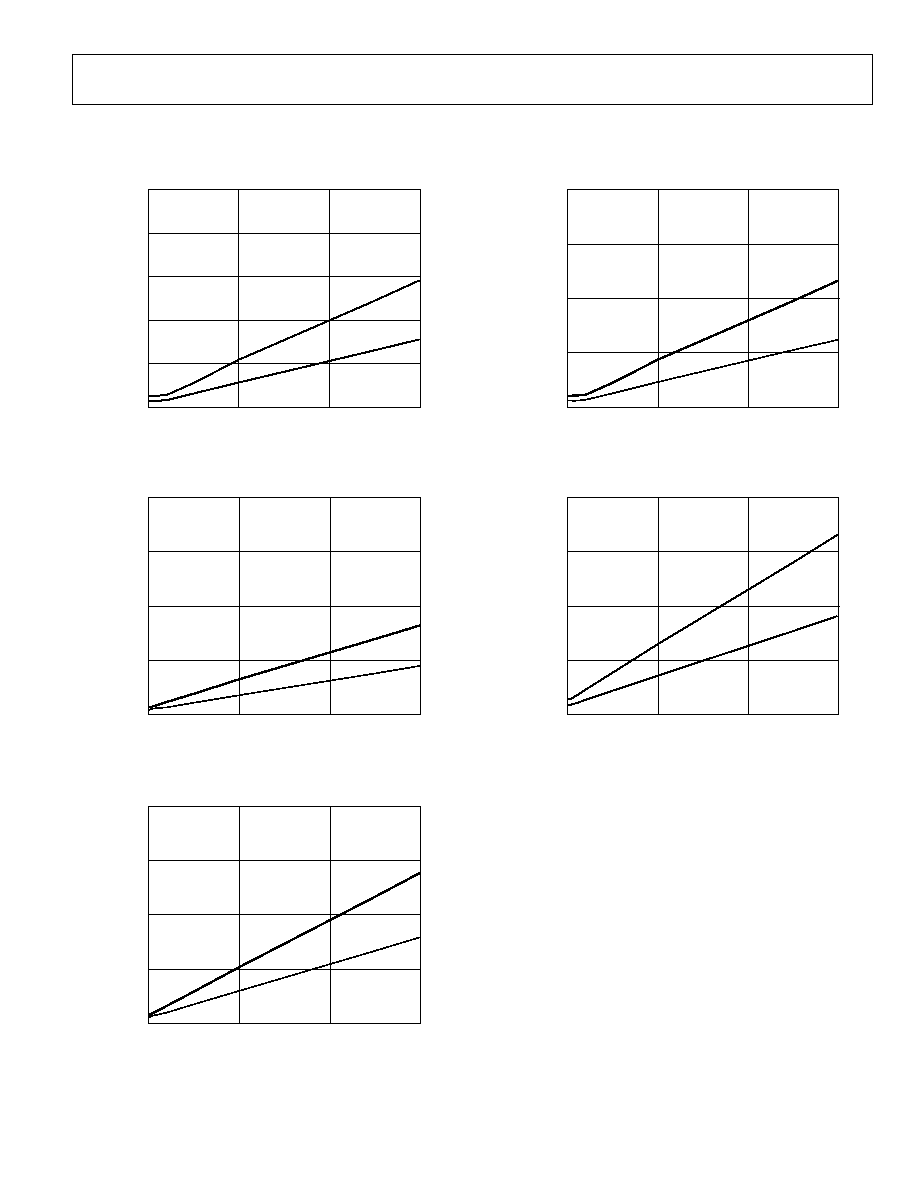
ADuM1210
Rev. 0 | Page 13 of 16
TYPICAL PERFORMANCE CHARACTERISTICS
05459-004
DATA RATE (Mbps)
CURRENT/CHANNEL (mA)
0
0
6
2
8
10
10
20
30
5V
3V
4
Figure 4. Typical Input Supply Current per Channel vs. Data Rate
for 5 V and 3 V Operation
05459-005
DATA RATE (Mbps)
CURRENT/CHANNEL (mA)
0
0
3
2
1
4
10
20
30
5V
3V
Figure 5. Typical Output Supply Current per Channel vs. Data Rate
for 5 V and 3 V Operation (No Output Load)
05459-006
DATA RATE (Mbps)
CURRENT/CHANNEL (mA)
0
0
3
2
1
4
10
20
30
5V
3V
Figure 6. Typical Output Supply Current per Channel vs. Data Rate
for 5 V and 3 V Operation (15 pF Output Load)
05459-007
DATA RATE (Mbps)
CURRENT (mA)
0
0
15
10
5
20
10
20
30
5V
3V
Figure 7. Typical ADuM1210 V
DD1
Supply Current vs. Data Rate
for 5 V and 3 V Operation
05459-008
DATA RATE (Mbps)
CURRENT (mA)
0
0
3
2
1
4
10
20
30
5V
3V
Figure 8. Typical V
DD2
Supply Current vs. Data Rate
for 5 V and 3 V Operation
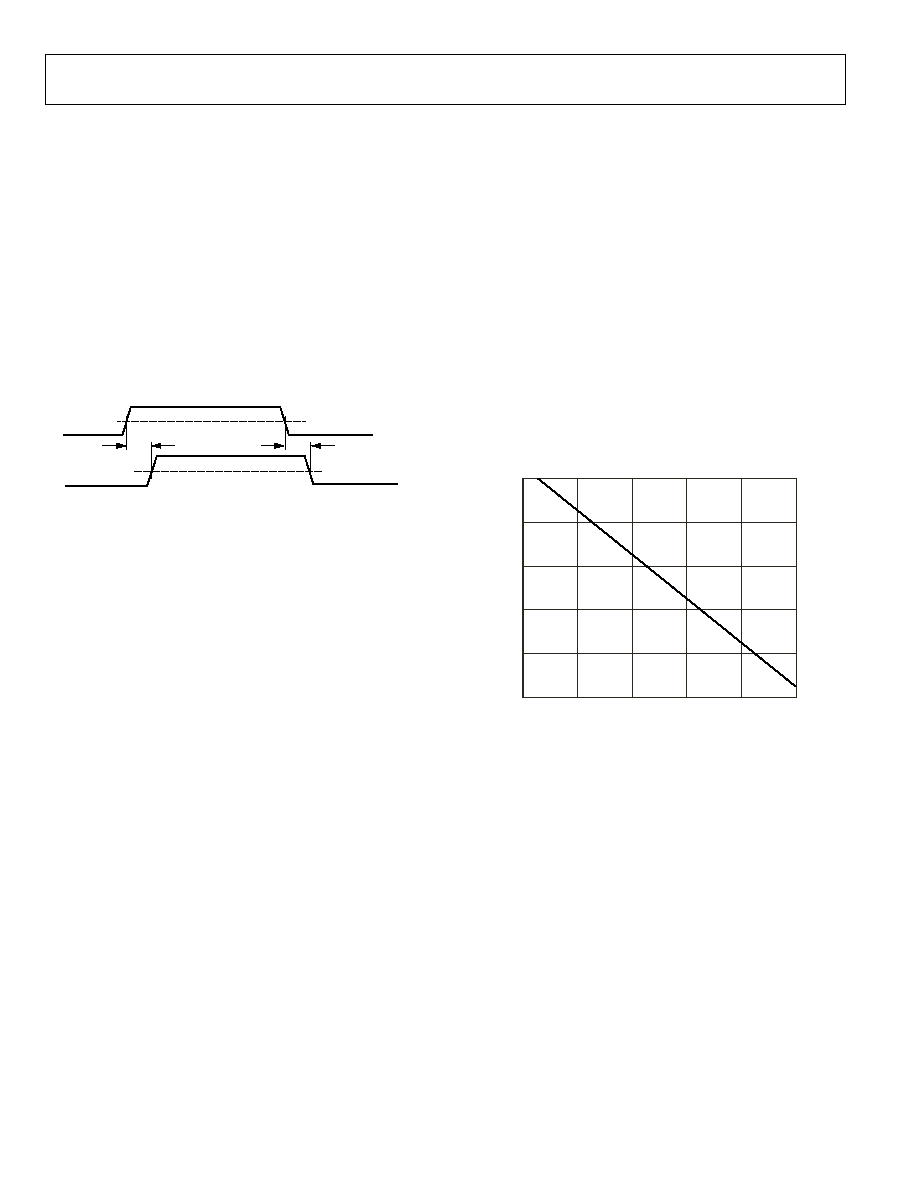
ADuM1210
Rev. 0 | Page 14 of 16
APPLICATION INFORMATION
PC BOARD LAYOUT
The ADuM1210 digital isolator requires no external interface
circuitry for the logic interfaces. Power supply bypassing is
strongly recommended at the input and output supply pins. The
capacitor value should be between 0.01 F and 0.1 F. The total
lead length between both ends of the capacitor and the input
power supply pin should not exceed 20 mm.
PROPAGATION DELAY-RELATED PARAMETERS
Propagation delay is a parameter that describes the time it takes
a logic signal to propagate through a component. The
propagation delay to a logic low output may differ from the
propagation delay to a logic high output.
INPUT (V
IX
)
OUTPUT (V
OX
)
t
PLH
t
PHL
50%
50%
05459-009
Figure 9. Propagation Delay Parameters
Pulse width distortion is the maximum difference between the
two propagation delay values and is an indication of how
accurately the input signal's timing is preserved.
Channel-to-channel matching refers to the maximum amount
that the propagation delay differs between channels within a
single ADuM1210 component.
Propagation delay skew refers to the maximum amount that the
propagation delay differs between multiple ADuM120x
components operating under the same conditions.
DC CORRECTNESS AND MAGNETIC FIELD IMMUNITY
Positive and negative logic transitions at the isolator input cause
narrow (~1 ns) pulses to be sent to the decoder via the
transformer. The decoder is bistable and is therefore either set
or reset by the pulses, indicating input logic transitions. In the
absence of logic transitions of more than 2 s at the input, a
periodic set of refresh pulses indicative of the correct input state
are sent to ensure dc correctness at the output. If the decoder
receives no internal pulses for more than about 5 s, the input
side is assumed to be unpowered or nonfunctional, in which
case the isolator output is forced to a default state (see Table 8)
by the watchdog timer circuit.
The ADuM1210 is extremely immune to external magnetic
fields. The limitation on the ADuM1210's magnetic field
immunity is set by the condition in which induced voltage in
the transformer's receiving coil is sufficiently large to either
falsely set or reset the decoder. The following analysis defines
the conditions under which this may occur. The 3 V operating
condition of the ADuM1210 is examined because it represents
the most susceptible mode of operation.
The pulses at the transformer output have an amplitude greater
than 1.0 V. The decoder has a sensing threshold at about 0.5 V,
therefore establishing a 0.5 V margin in which induced voltages
can be tolerated. The voltage induced across the receiving coil is
given by
=
-
=
N
n
r
dt
d
V
n
,...
2
,
1
;
)
/
(
2
where:
is the magnetic flux density (gauss).
N is the number of turns in the receiving coil.
r
n
is the radius of the nth turn in the receiving coil (cm).
Given the geometry of the receiving coil in the ADuM1210 and
an imposed requirement that the induced voltage is at most
50% of the 0.5 V margin at the decoder, a maximum allowable
magnetic field is calculated, as shown in Figure 10.
MAGNETIC FIELD FREQUENCY (Hz)
100
MAX
IMUM ALLO
W
ABLE
MAG
NE
T
IC FLUX
DE
NS
ITY
(kgauss)
0.001
1M
10
0.01
1k
10k
10M
0.1
1
100M
100k
05459-010
Figure 10. Maximum Allowable External Magnetic Flux Density
For example, at a magnetic field frequency of 1 MHz, the
maximum allowable magnetic field of 0.2 kgauss induces a
voltage of 0.25 V at the receiving coil. This is about 50% of the
sensing threshold and does not cause a faulty output transition.
Similarly, if such an event occurs during a transmitted pulse
(and had the worst-case polarity), it would reduce the received
pulse from > 1.0 V to 0.75 V--still well above the 0.5 V sensing
threshold of the decoder.
The preceding magnetic flux density values correspond to
specific current magnitudes at given distances away from the
ADuM1210 transformers. Figure 11 expresses these allowable
current magnitudes as a function of frequency for selected
distances. As seen, the ADuM1210 is extremely immune and
can be affected only by extremely large currents operated at
high frequency and very close to the component. For the 1 MHz
example, one would have to place a 0.5 kA current 5 mm away
from the ADuM1210 to affect the component's operation.
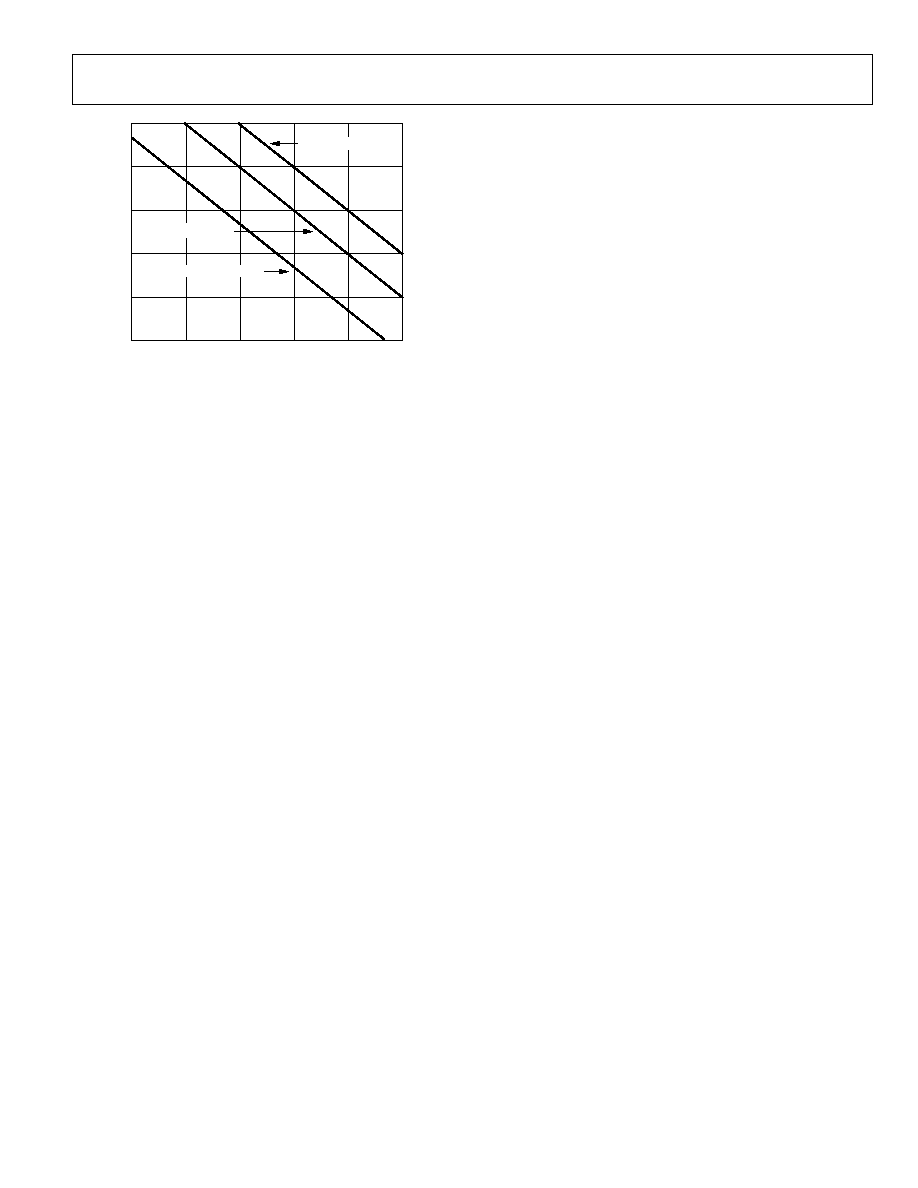
ADuM1210
Rev. 0 | Page 15 of 16
MAGNETIC FIELD FREQUENCY (Hz)
MAXIMUM AL
L
O
WABL
E CURRENT
(
k
A)
1000
100
10
1
0.1
0.01
1k
10k
100M
100k
1M
10M
DISTANCE = 5mm
DISTANCE = 1m
DISTANCE = 100mm
05459-011
Figure 11. Maximum Allowable Current for Various
Current-to-ADuM1210 Spacings
Note that at combinations of strong magnetic fields and high
frequencies, any loops formed by printed circuit board traces
could induce sufficiently large error voltages to trigger the
threshold of succeeding circuitry. Care should be taken in the
layout of such traces to avoid this possibility.
POWER CONSUMPTION
The supply current at a given channel of the ADuM1210
isolator is a function of the supply voltage, the channel's data
rate, and the channel's output load.
For each input channel, the supply current is given by
I
DDI
= I
DDI (Q)
f 0.5f
r
I
DDI
= I
DDI (D)
× (2f f
r
) + I
DDI (Q)
f > 0.5f
r
for each output channel, the supply current is given by
I
DDO
= I
DDO (Q)
f 0.5f
r
I
DDO
= (I
DDO (D)
+ (0.5 × 10
-3
) × C
L
V
DDO
) × (2f f
r
) + I
DDO (Q)
f > 0.5f
r
where:
I
DDI (D)
, I
DDO (D)
are the input and output dynamic supply currents
per channel (mA/Mbps).
C
L
is the output load capacitance (pF).
V
DDO
is the output supply voltage (V).
f is the input logic signal frequency (MHz, half of the input data
rate, NRZ signaling).
f
r
is the input stage refresh rate (Mbps).
I
DDI (Q)
, I
DDO (Q)
are the specified input and output quiescent
supply currents (mA).
To calculate the total I
DD1
and I
DD2
supply current, the supply
currents for each input and output channel corresponding to
I
DD1
and I
DD2
are calculated and totaled. Figure 4 and Figure 5
provide per-channel supply currents as a function of data rate
for an unloaded output condition. Figure 6 provides per-
channel supply current as a function of data rate for a 15 pF
output condition. Figure 7 and Figure 8 provide total I
DD1
and
I
DD2
supply current as a function of data rate.
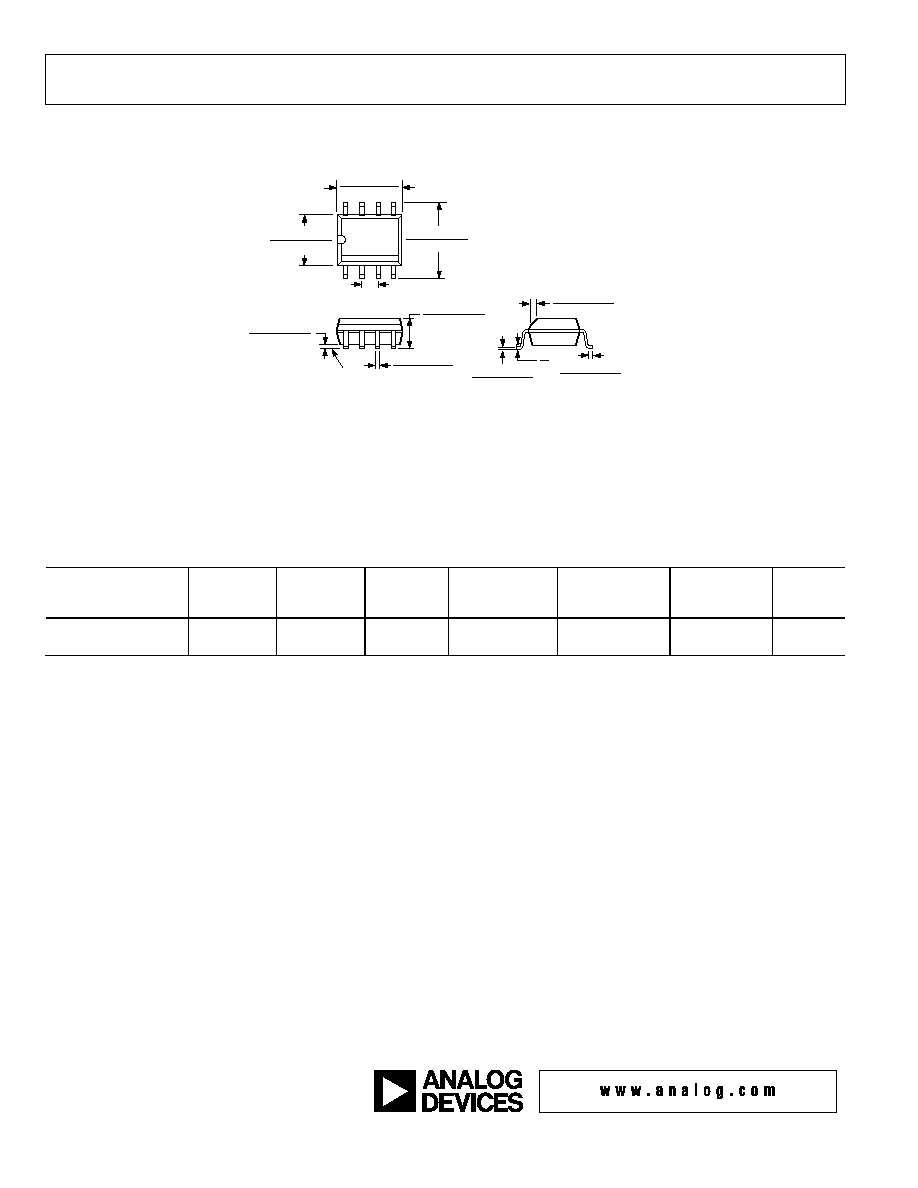
ADuM1210
Rev. 0 | Page 16 of 16
OUTLINE DIMENSIONS
0.25 (0.0098)
0.17 (0.0067)
1.27 (0.0500)
0.40 (0.0157)
0.50 (0.0196)
0.25 (0.0099)
×
45°
8°
0°
1.75 (0.0688)
1.35 (0.0532)
SEATING
PLANE
0.25 (0.0098)
0.10 (0.0040)
4
1
8
5
5.00 (0.1968)
4.80 (0.1890)
4.00 (0.1574)
3.80 (0.1497)
1.27 (0.0500)
BSC
6.20 (0.2440)
5.80 (0.2284)
0.51 (0.0201)
0.31 (0.0122)
COPLANARITY
0.10
CONTROLLING DIMENSIONS ARE IN MILLIMETERS; INCH DIMENSIONS
(IN PARENTHESES) ARE ROUNDED-OFF MILLIMETER EQUIVALENTS FOR
REFERENCE ONLY AND ARE NOT APPROPRIATE FOR USE IN DESIGN
COMPLIANT TO JEDEC STANDARDS MS-012-AA
Figure 12. 8-Lead Standard Small Outline Package [SOIC_N]
Narrow Body
(R-8)
Dimensions shown in millimeters and (inches)
ORDERING GUIDE
Model
Number of
Inputs,
V
DD1
Side
Number of
Inputs,
V
DD2
Side
Maximum
Data Rate
(Mbps)
Maximum
Propagation
Delay, 5 V (ns)
Maximum
Pulse Width
Distortion (ns)
Temperature
Range (°C)
Package
Option
1
ADuM1210BRZ
2
2
0
10
50
3
-40 to +105
R-8
ADuM1210BRZ-RL7
2
2
0
10
50
3
-40 to +105
R-8
T
1
R-8 = 8-lead, narrow body SOIC.
2
Z = Pb-free part.
© 2005 Analog Devices, Inc. All rights reserved. Trademarks and
registered trademarks are the property of their respective owners.
D0545907/05(0)
TTT
Document Outline
- þÿ
- þÿ
- GENERAL DESCRIPTION
- þÿ
- þÿ
- þÿ
- þÿ
- þÿ
- ELECTRICAL CHARACTERISTICS3 V OPERATION
- ELECTRICAL CHARACTERISTICSMIXED 5 V/3 V OR 3 V/5 V OPERATION
- PACKAGE CHARACTERISTICS
- þÿ
- þÿ
- DIN EN 60747-5-2 (VDE 0884 PART 2) INSULATION CHARACTERISTICS
- þÿ
- þÿ
- þÿ
- þÿ
- þÿ
- þÿ
- þÿ
- þÿ
- POWER CONSUMPTION
- þÿ















